The Acer Nitro 5 Review: Renoir And Turing On A Budget
by Brett Howse on October 9, 2020 8:00 AM ESTSystem Performance: AMD Renoir H
AMD’s Renoir platform has been a game-changer in the laptop space for the Santa Clara company. With the previous laptop platform, Picasso, AMD offered competitive,, but not class-leading performance, especially on their integrated GPU, but were let down by high platform power draw, which was a major hurdle to overcome in a battery-powered device. Also, Picasso featured the AMD Zen CPU cores, whereas AMD’s desktop platform had moved to Zen 2. With the introduction of the AMD 4000 series laptop platform known as Renoir, AMD really delivered a triple-punch, moving to their newest 7 nm Zen 2 cores, as well as addressing their high idle power draw, and offering up to eight cores and sixteen threads in both their U-Series 15-Watt designs, and H / HS series 45-Watt / 35-Watt laptop processors. AMD went from “competitive, but” to class-leading overnight.
For a full deep-dive into the AMD 4000 platform, please check out Ian’s launch-day review featuring the AMD Ryzen 9 4900HS.
Moving back to the Acer Nitro 5, Acer is offering two Renoir-based options, with the entry-level design featuring an AMD Ryzen 5 4600H, and the upgraded model moving to the Ryzen 7 4800H. Both are nominal 45-Watt TDP parts, with the Ryzen 5 offering six cores and twelve threads, from 3.0 to 4.0 GHz. The 4800H offers eight cores and sixteen threads, from 2.9 to 4.2 GHz. In our Ryzen 5 powered review unit, the processor is paired with 8 GB of DDR4 RAM in a single-channel configuration, which will somewhat impact CPU performance, but offers the owner an easier, less expensive option to upgrade to 16 GB in the future.
To see how the Acer Nitro 5 performs, it was run through our laptop benchmark suite. To compare the results to any device we have tested, please use our online Bench. As an interesting comparison we have included the ASUS ROG Zephyrus M15, powered by a six-core i7-10750H, with the same TDP and core count as the AMD Ryzen 5 4600H in the Acer Nitro 5, as well as the eight-core Ryzen 7 4700U powered Acer Swift 3, and some quad-core Ice Lake platforms with and without dedicated graphics. The comparison systems are not based on price – the Acer Nitro 5 is easily the most inexpensive device here with a dGPU – but on platforms, so please keep that in mind. Where possible, the ASUS Zephyrus G14, which was the launch platform for the Ryzen 4000 series, is also included, however Ian’s CPU testing suite does not perfectly match the Laptop suite, so data is not available for all tests.
PCMark 10
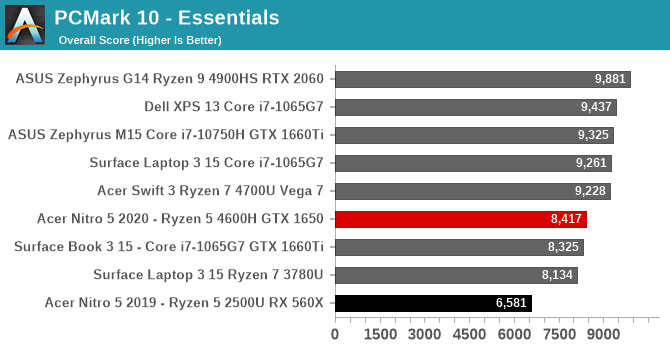
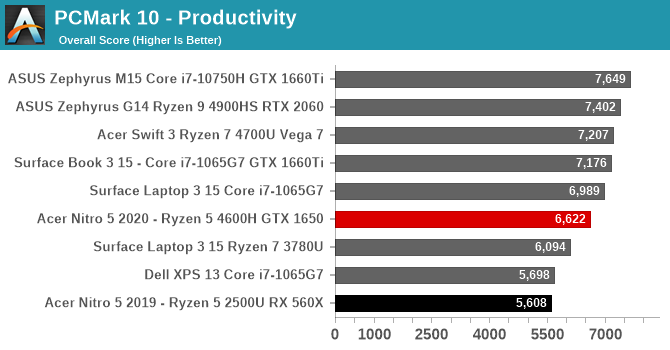
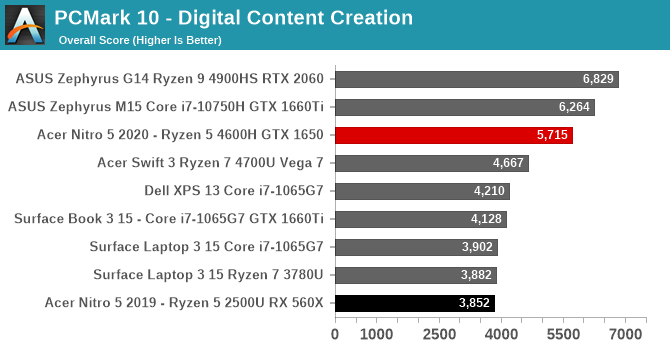
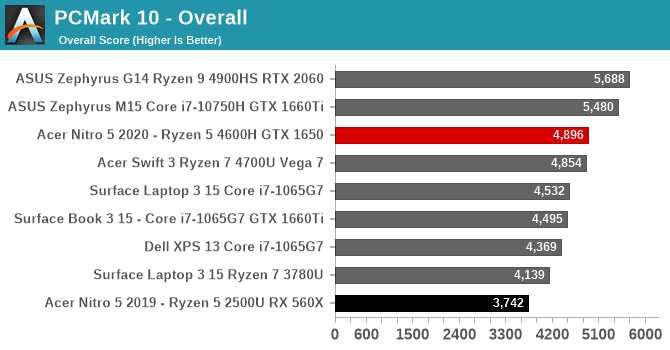
Offering a range of sub-tests, UL’s PCMark 10 simulates real-world tasks for office productivity, digital content creation, and typical tasks a home-user may do such as web and video chats. The Acer Nitro 5 does very well here, although it can not quite match the 8-core Ryzen 7 4700U in many of the tests. The included GTX 1650 does propel it ahead in content creation, however. The ASUS M17, with a 5.0 GHz maximum frequency, does edge the Ryzen 5 4600H, and the large GTX 1660 Ti GPU also helps. However the ASUS Zephyrus G14 with the “35-Watt” Ryzen 9 4900HS and RTX 2060 is able to outshine the rest of the systems.
Cinebench R20
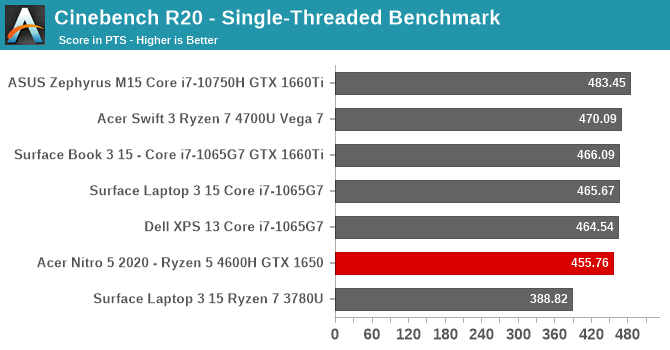
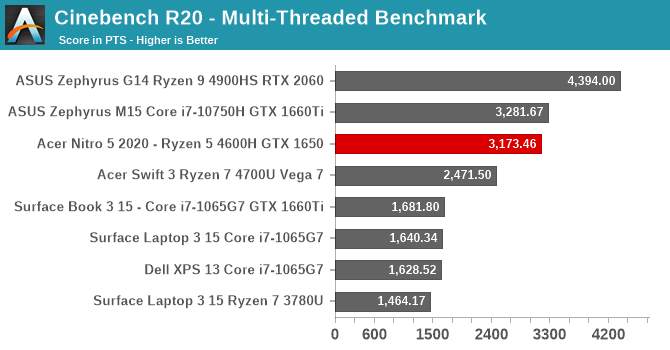
Cinebench is a pure compute workload, testing a CPU’s execution resources without much else getting in the way, like memory. It favors fast frequencies, high IPC, and more cores on the multi-threaded version of the test. The slightly lower boost frequency of the Ryzen 5 4600H, peaking at only 4.0 GHz, holds the system back on the single-threaded results, but with six cores and twelve total threads, the Ryzen 5 competes well with the Core i7-10750H, and stretches its legs on the U-Series processors. The Ryzen 9 4900HS, with 8 cores, 16 threads, and a 4.3 GHz maximum turbo, easily outclasses other processors here.
Handbrake

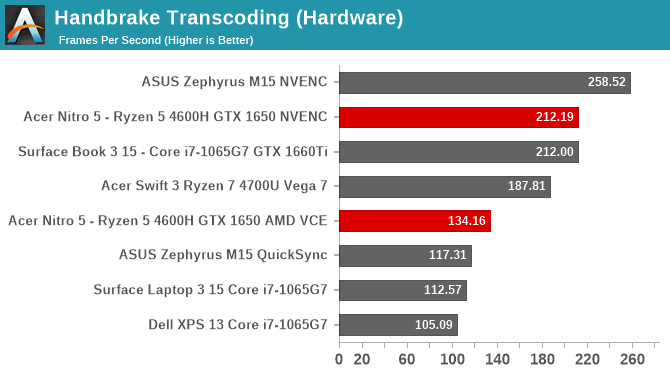
The newly added Handbrake benchmark leverages the CPU, integrated GPU, and discrete GPU if available to transcode video using likely the most popular transcoding tool around. As a much longer test, the TDP plays more of a factor here than on some of the previous results, and the Acer Nitro 5 does very well on this assessment. On pure CPU encoding, the Zen 2 cores can almost keep up with the much higher frequency Core i7-10750H. When using the integrated GPU built into Ryzen, performance is good, although not quite matching the Ryzen 7 4700U we tested in the Acer Swift 3, which despite the smaller TPD, offers a slightly larger iGPU. The GeForce GTX 1650 is faster again, if you need to transcode video in a hurry. Generally, the dedicated media blocks perform the job quicker, but not necessarily with the same quality as the software based encoder, which may factor into your decision on which one to leverage for a transcode job.
7-Zip
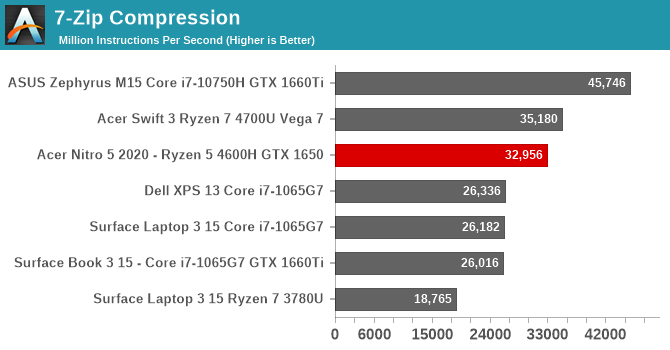
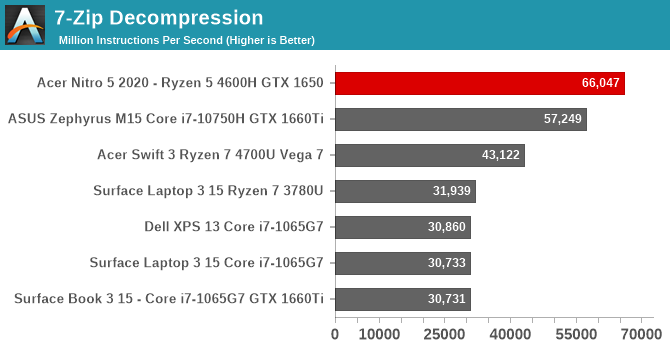
The very popular open-source file compression utility 7-Zip includes a built-in benchmark, showing the compression and decompression rates in MIPS. The Ryzen 5 can’t quite hang with the Ryzen 7 4700U in compression, but the Zen 2 cores do very well in the decompression result.
Web Workloads
Measuring web performance is a factor of both the underlying hardware, as well as the browser, since most web workloads leverage scripting which is compiled just-in-time, so the browser plays a big factor in overall performance. To lock the systems to an even playing field, we have moved to the latest Chromium-based Microsoft Edge browser, and will be utilizing it going forward. We took the opportunity to move away from some of the older, outdated web tests, and are focusing on Speedometer 2.0, which is a DOM performance measurement from the Webkit team, and WebXPRT which is developed by Principled Technologies.
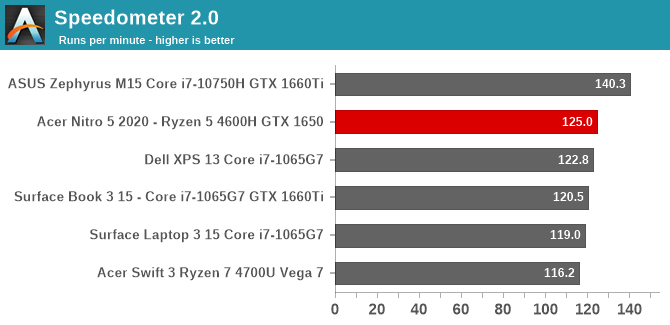
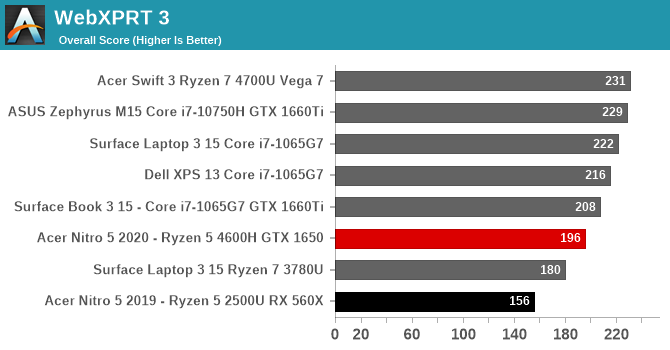
Interestingly, the 6-core, 12-thread Acer Nitro 5 was able to surpass the 8-core, 8-thread Ryzen 4700U in Speedometer, even with a small frequency deficit. WebXPRT, which really favors higher turbos and fast turbo activation, did not do as well on this system.
Storage Performance
The Acer Nitro 5 review unit shipped with a 256 GB Western Digital SN530 drive, which is a PCIe 3.0 x4 NVMe drive. The Acer also offers an additional M.2 port, as well as a 2.5-inch SATA slot for additional expansion. As a low-cost device, the 256 GB drive is small, but adequate when you consider the rest of the internals, and expansion is possible, either via internal drives, or of course USB-based storage to hold a gaming library.
The PCMark 10 storage test uses traces of actual workloads to provide an overall resulting score, and is more useful than a straight up bandwidth test of the drive.
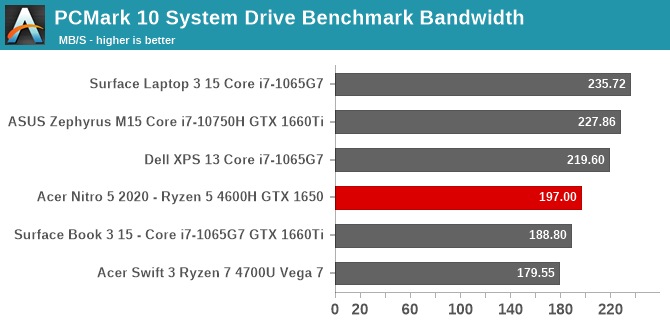
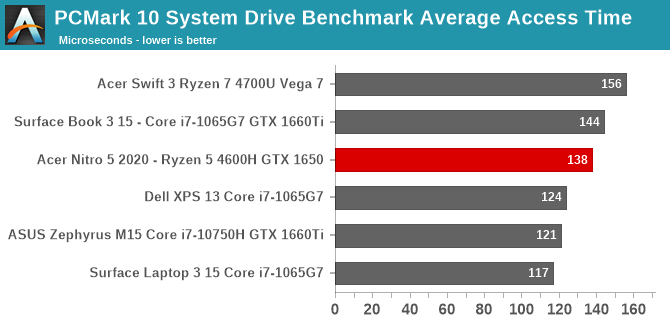

The drive itself, despite being installed in a low-cost device, holds up well against other devices we have tested that cost much more. A larger drive in a gaming system would be nice, due to the massive size of game installs in 2020, but a 256 GB system drive is still welcome since it is pure NVMe SSD.











50 Comments
View All Comments
Mogvil20 - Thursday, October 22, 2020 - link
Details About Card activationGreat Article. Thank you for sharing! Really an awesome post for everyone.
http://philagribiz.com/
Operandi - Friday, October 9, 2020 - link
Midrange AMD notebooks are something we've had forever this is boring. Where are the high-end Renoir based ultrabooks?vlayceh - Friday, October 9, 2020 - link
All derivatives of GTX 1650 for laptops have 1024 cores while 1650 desktop has 896 cores. Your article mentions 896 cores which I suppose is an error.lightningz71 - Friday, October 9, 2020 - link
Unfortunately, the GPU-Z screen capture that is shown on the GPU Performance page clearly indicates only 896 pipelines.An earlier article near the release of the 1650 mobile indicated that it could be configured with multiple pipeline enablement configurations and multiple power targets, and that few vendors were ever going to note how their particular implementation was done. The only way to absolutely insure that your 1650 was fully enabled, and also equipped with GDDR6, would be to get a 1650TI version.
treecats - Friday, October 9, 2020 - link
lol, what a terrible idea. AMD Ryzen 4600H and 4800H already included Vega graphics. Why bother including a discrete graphic card. Get rid of the graphic card and use that money to improve the screen on the base model, and this will make the laptop thinner, lighter and probably cheaper. more attractive to potential buyers. People wants a gaming laptop wouldn't want to buy this, they rather spend more money.Otritus - Friday, October 9, 2020 - link
This machine provides adequate 1080p gaming performance. As someone whos gamed on a 750 ti from 2015 to today, this would be an excellent step up in performance. And frankly this is not trying to be a cheap thin and light, but a machine that will give you solid performance at a cheap price. Not everyone can afford $800+ laptops, and the compromises to hit $670 seem fair.Bobby3244 - Friday, October 9, 2020 - link
Any reason why we don't see the CPU clocks in the Far Cry thermals? I had a friend pick up a gaming laptop with ryzen 4800h and a 5600M (Dell something), and the CPU clocks when playing games was horrible (2500~ Mhz), which was promptly returned. As far as thermals go, this one looks better, but I would still like to see the clock speed of the CPU.Brett Howse - Friday, October 9, 2020 - link
GPU-Z only grabs the CPU temperatures.nicolaim - Friday, October 9, 2020 - link
The port selection is so 2017...Otritus - Friday, October 9, 2020 - link
I've been noticing the value gaming settings is 13x7. While this seems fine on older integrated gfx solutions, the improved gaming performance of tiger like (and likely cezanne) seems like this resolution could be buffed to 1080p, especially because budget discrete gpus like the 1650 seem like an excellent 1080p medium to high card (and faster budget gpus are coming).And frankly for the games that I play at 1080p, I can either easily hit 60 fps on a 750 ti, or am fine with reducing the eye candy or sacrificing fps when compared to 720p. So a value 1080p might be better representative for entry-level gaming in 2020.